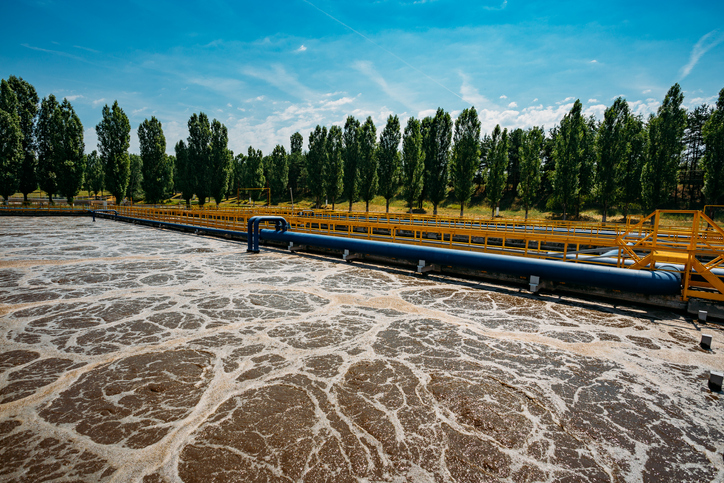Removing phosphorus from wastewater is critical to maintaining healthy water resources and protecting the health of communities. However, the traditional coagulants used to remove phosphorus to low levels consume the natural alkalinity in the wastewater, resulting in low pH and inhibiting the microbes that consume the carbonaceous waste and ammonia.
Microbes need a stable pH, close to neutral, to thrive and perform their function of consuming pollutants.
The optimum pH for bacterial growth is generally between 6.5 and 7.5, but the optimal range will vary depending upon the type of bacteria. It is this bacterial growth that converts carbonaceous pollutants and ammonia into cell growth, along with reproducing to create new cells, new “bugs”, thereby removing those pollutants as biomass and purifying the wastewater.
For carbonaceous removing bugs, the tolerable range is 6.0 to 9.0 but the optimal is near a neutral pH of 7. This near neutral pH will provide the best conditions for cell growth and carbon uptake. This is the most common biological process in wastewater treatment.
Nitrifiers, those bugs that oxidize ammonia to nitrite and then further oxidize it to form nitrate, are more pH sensitive. The optimal pH range for nitrifiers is between 7.5 to 8.0, and the rate of ammonia conversion declines dramatically at a pH below 6.8. It is important to note that nitrifiers also consume alkalinity, so the pH can decline some just due to the nitrification process. In wastewaters with low natural alkalinity, pH adjustment may be required even without phosphorus removal. To accommodate both nitrifiers and carbonaceous removing bugs, most facilities try to maintain a pH of between 7.0 and 7.2.
Denitrification, the process of converting nitrates and nitrites to nitrogen gas, requires yet another class of bugs and anoxic (no oxygen) conditions. It is not as common as the previous two types of treatment, but some facilities have total nitrogen (ammonia, nitrate, and nitrite) limits. Alkalinity is increased by the denitrification process, so the pH typically rises. Studies have shown no significant decline in denitrification rates when pH is held between 7.0 and 8.0, but some studies indicate that there may be a decline as the pH drops from 7.0 to 6.0.
Bottom line, all classes of pollutant removing bugs operate best within a narrow range on pH that is roughly neutral, between 7.0 and 7.2. Maintaining this pH level and the natural alkalinity that acts as a buffer is vital for healthy bugs, reproduction, and the removal of pollutants.
Traditional coagulants have low pH and require high doses, consuming alkalinity.
The pH balance gets much more complex if phosphorus removal is required. Traditional phosphorus (P) removal coagulants have a very low pH of around 2. Keep in mind that pH is a logarithmic scale, so a pH of 2 is 100,000 times more acidic than a pH of 7. Adding just a little of these coagulants can dramatically alter the pH of the system, shifting pH out of the optimal zone.
The chemistry of phosphorus removal using these coagulants further complicates the pH balance. These coagulants are not selective for phosphorus, but also react with other wastewater constituents. That means that to achieve a moderate level of P removal may require a dosage of 4 to 1 coagulant to phosphorus. BUT, to achieve a low limit may require a dosage ratio as high as 10 to 1 coagulant to phosphorus, as more side reactions come into play. It is easy to see how the pH of your system can easily become destabilized, impacting your treatment, and making pH adjustment (and careful monitoring) a necessity.
P removal with WaterFX is stable, predictable and preserves more of your natural alkalinity.
WaterFX is selective for phosphorus, reacting preferentially with it. This means that the dosage is predictable and very close to 1 to 1 WaterFX to P. If influent P increases or your limit is reduced, the amount of WaterFX required will increase in a linear 1 to 1 manner, not tripling or quadrupling as may be required with traditional coagulants. This low, predictable dose is a key advantage when considering WaterFX’s impact on pH.
The second advantage is that WaterFX is less acidic, with a pH between 3 to 4, making it 10 to 100 times less acidic than traditional coagulants. Combined with the much lower dosage, WaterFX typically adds 1000 to 5000 times less acidity to your wastewater, thereby consuming very little of your wastewater’s natural alkalinity. This helps keep the pH much more stable. Your bugs can do their work of consuming pollutants and multiplying in conditions that are close to optimal, often without any additional pH adjustment. Healthy bugs make for better treatment, and that is the WaterFX advantage.
If healthy bugs sound good to you, give us a call.
If preserving your natural alkalinity and stabilizing your pH for healthier bugs and better treatment is part of your operational strategy, contact us to see how phosphorus removal with Neo WaterFX can make that a reality! The consultation is free. Learn why so many facilities are switching to WaterFX for their phosphorus removal.



